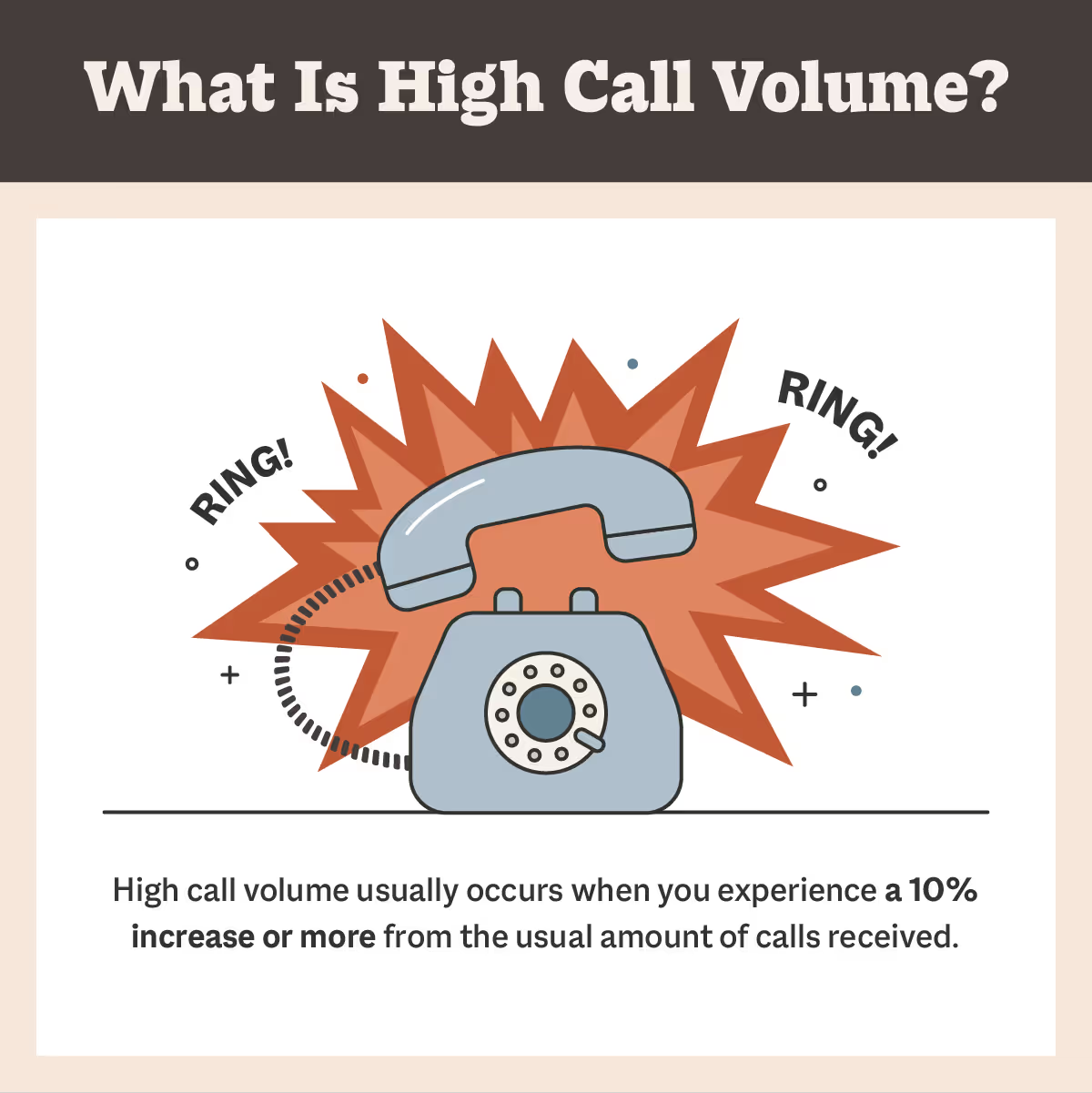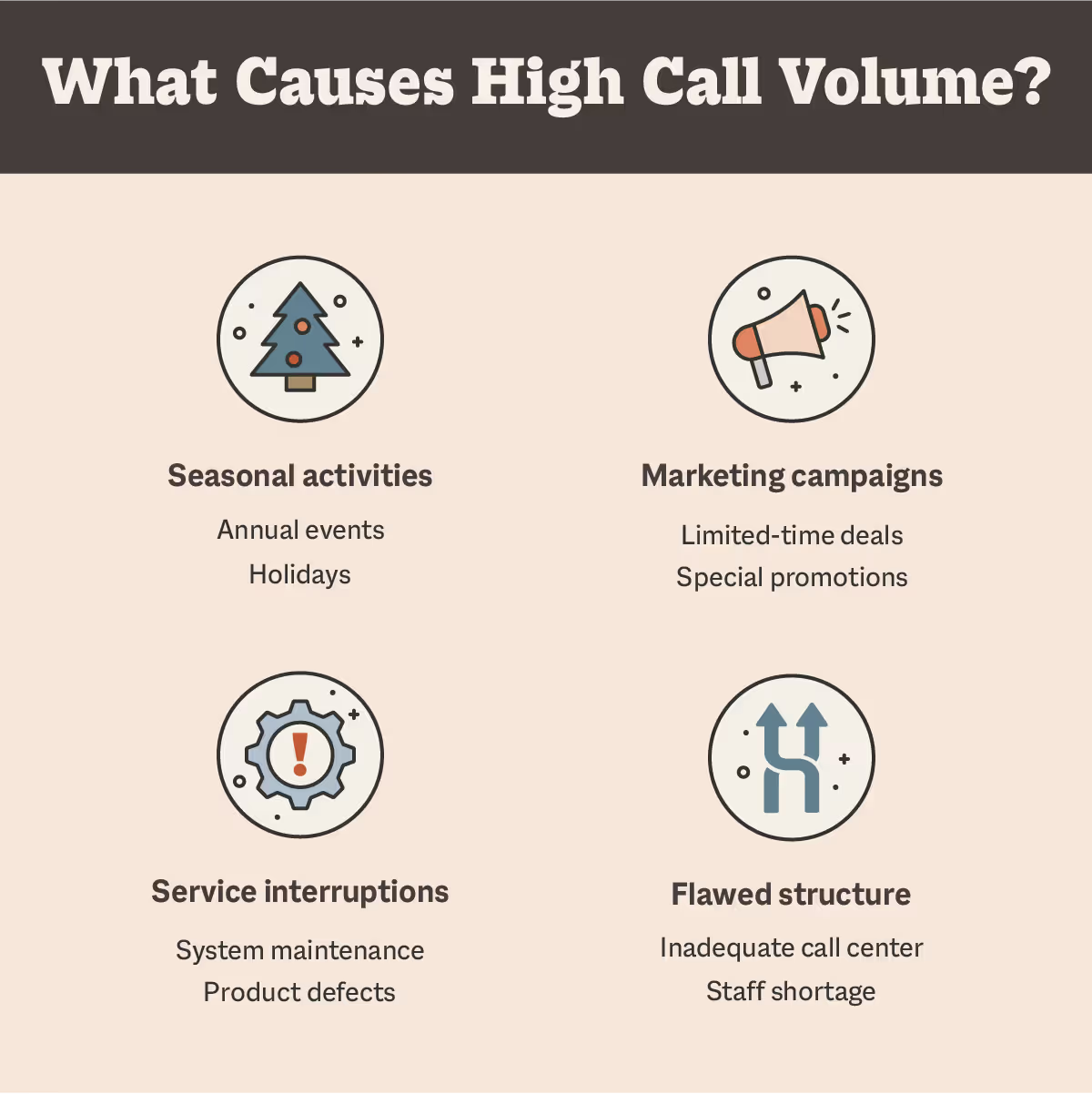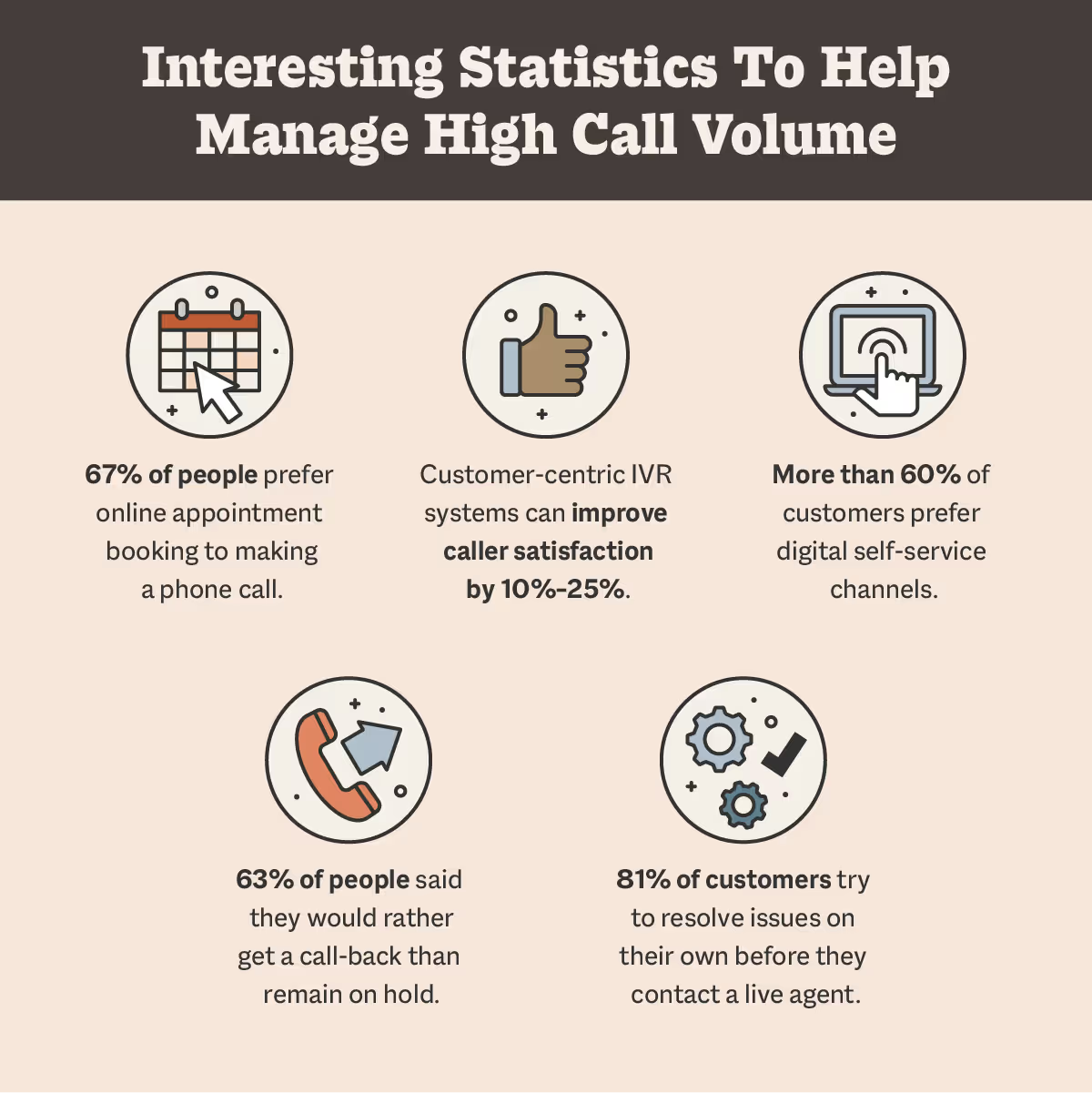15 Ways to Successfully Manage High Call Volume
15 Ways to Successfully Manage High Call Volume

Floods of incoming calls can be a double-edged sword. On one hand, high call volume can indicate that your business is thriving. On the other hand, it can be challenging to manage all of those calls and provide sufficient attention to each caller at the same time.
If you aren’t prepared, unexpected high call volume can have significant effects on a business, especially smaller ones with fewer resources.
With 78% of customers claiming that waiting on hold for too long is the #1 most annoying aspect of calling a company, efficiently managing your high call volume should be a priority to ensure your customers are satisfied.
Continue reading to learn more about high call volume, its causes, and 15 effective methods to handle it in your company.

What does high call volume mean?
High call volume happens when your business receives more incoming calls than your own staff or answering service is prepared to handle.
In order for a surge of calls to be considered high call volume, they must continue for a sustained length of time, which, depending on your industry, might be two to three weeks.
High call volume usually occurs when you experience a 10% increase from the usual amount of calls received. However, for small- and medium-sized businesses, that figure can be significantly higher depending on available resources.
What causes high call volume?
There are numerous factors that could contribute to a high call volume at your company.

Here are a few of the main causes:
- Seasonal activities: Holidays and other seasonal activities, such as special promotions or annual events, can be a significant factor in increased call volume.
- Marketing campaigns: Your firm may experience an increase in calls if you conduct a particularly effective marketing campaign that increases traffic.
- Service interruptions: When a natural disaster or scheduled maintenance causes your service to be stopped, or your product has a defect, you can encounter a spike in customer support calls.
- Flawed organizational structure: Backlogs caused by poorly organized call centers or inadequate in-house staff might result in excessive call volumes when call demand exceeds the available supply of people available to answer calls.
15 Ways to manage high call volume
Let's assume for the moment that you are receiving a lot of calls. How do you address it? Here are 15 ways to help you manage your high call volume.

1. Establish data-driven forecasts
Did you know: 65% of businesses say improving their data analysis is critical to delivering a better customer experience.
Even though certain call volume increases may be unanticipated, you can lessen these unpleasant surprises by closely monitoring your call data. Start by reviewing prior years' data, then look for any patterns where call volume starts to increase.
Once you’ve found those patterns, ask yourself the following questions:
- Were any seasonal sales or holidays going on at that time?
- Were any promotional deals or other campaigns going on at that time?
- Was there a defect in a recently released product?
- Did any service interruptions occur?
- Were you understaffed at that time?
You can anticipate potential events that might result in an eventual rise by having an understanding of the reasons for these increases. Your team will be more ready if you can establish data-driven forecasts.
2. Install an interactive voice response system
Did you know: Customer-centric IVR systems can improve caller satisfaction by 10%-25%.
When a customer phones your business, they should receive a response immediately. While ideally this implies that they are linked to one of your agents, it doesn't mean that they must be chatting to a live person.
IVRs, or interactive voice response systems, can automate the distribution of support cases to the rest of your staff by imitating human agents. IVRs give customers a menu of alternatives to select from, and each choice connects them to a resource or agent who can help rather than putting them on hold right away once they call your support line.
As a result, there will be fewer calls for agents to answer and transfers for them to make while they are on a call.
3. Offer a call-back service
Did you know: 63% of people said they would rather request a call-back than remain on hold.
If you are experiencing high call volume, an effective method to help manage is offering a call-back service.
Instead of making your customers wait on hold for the next available representative, they can opt for a call-back when it’s their turn in line. This not only improves the customer experience, but it also cuts down on the volume of calls that come in at once.
It’s a win-win for everyone since customers save time and hassle, and representatives are able to spread out the day's call traffic more evenly.
4. Give agents the right tools
Did you know: 89% of consumers are retained when businesses utilize an omnichannel customer interaction strategy.
Giving agents workflow tools, like an omnichannel system, is one of the best ways to achieve efficiency. An omnichannel phone system gives agents access to previous client conversations, to get them up to speed on past topics of conversation, enabling them to handle calls more quickly and effectively.
This technology enables the unification of all communication channels within your company, including your CRM platform and employee project management software.
When your operating systems are integrated, they are all working toward the same objective, which is to enhance the customer experience.
5. Utilize automation
Did you know: 86% of workers believe automation will enable them to work more productively and grow their businesses.
Your team can save time throughout a high call volume day with a variety of automation solutions. Workflows, for instance, can automate the routing of tickets and send pre-written follow-up emails to customers who don't reply to cases.
By doing this, the representative avoids having to type the email out by hand and proofread before sending. These minutes build up over time and have a significant impact on your team's overall effectiveness and productivity.
6. Install a live chat tool
Did you know: More than 60% of customers prefer digital self-service channels.
Another technique to cut down on incoming calls is to adopt a self-service tool such as live chat. Many businesses have started adopting online chat tools as common contact methods with great success. In fact, live chat has had a positive impact on sales, revenue, and customer loyalty according to 79% of organizations.
Customers can interact in real time with a member of your staff or outsourced agent using online chat capabilities. In comparison to phone calls, these tools provide quick communication while consuming less time and energy.
When clients need assistance, having a chat function embedded on your website can help them quickly and effectively locate this form of communication.
Even better, if your business has self-service resources set up on its website, agents can use live chat to refer clients to these pages, drastically cutting down on communication time.
7. Create a comprehensive knowledge hub and FAQ page
Did you know: 81% of customers try to resolve issues on their own before contacting a live representative.
Another great self-service resource is a knowledge hub or FAQ page on your website. These pages assist in deflecting frequent questions that only take a few minutes to address rather than fielding each inquiry from customers. That way, customers can help themselves before having to contact your team.
The more comprehensive and easy to navigate your resources are, the fewer questions and calls your customers will have. This frees up your team to concentrate on more complex questions or requests that require more time to resolve.
8. Offer online scheduling
Did you know: 67% of people prefer online appointment booking.
If your company relies on appointments, it's likely that most of the calls you receive are from clients looking to make new appointments or confirm or modify existing ones.
To reduce these types of calls, provide your customers with an online scheduling platform. You can implement one on your website, your company app, or even a messaging platform like Facebook Messenger.
9. Encourage customers to use other channels
Did you know: 66% of customers use at least three different channels to communicate with businesses.
Consumers today expect to be able to contact businesses through the channel of their choice. There are several effective ways to communicate with your customers, including chat (like mentioned above), email, and social media.
Spend some time learning which channels are most popular and convenient for your clients. Then, incorporate support functions into these channels to give clients a variety of ways to get in touch with your business.
Your call center or in-house team will handle fewer cases during a spike in service calls if you give your clients and customers more of these options.
Make sure all channels are integrated into a CRM so that if a customer contacts support more than once about a problem, all of the interactions display in the same location. Agents can more easily understand a customer's history and meet their needs by doing this.
10. Schedule your well-trained agents accordingly
If you anticipate a high call surge due to seasonality or other forecasted trends, make sure you have enough agents on hand to handle the increase in call volume. Your team may be able to better manage high call volume by scheduling more staff during your busiest call times.
While you're at it, it’s important to understand how many active reps you require on the floor and how many cases each agent can manage in a given amount of time. You want to assess your team and make sure you have enough agents on hand that are experienced enough to handle the increase in calls.
11. Be upfront with your customers
Did you know: 94% of customers prefer brands that practice transparency.
When callers have to hold for more than a few minutes, they frequently grow irritated and frustrated.
However, if you are up-front with your customer from the get-go, they’ll most likely feel more empathetic to your predicament. This also helps build rapport and a better connection with your customers.
You can implement an automated voice message letting callers know that you are experiencing high call volume at that time. In this message, make sure to offer helpful information such as:
- Expected wait time until the next available agent
- Alternative self-service channels
- Call-back service options
12. Remain professional
Dealing with high call volume can be overwhelming, but it’s important to ensure your agents remain professional at all times. Make sure your representatives are answering the phone professionally and are knowledgeable enough to navigate the calls efficiently.
To help ensure that every customer has a consistent experience with the same level of professionalism, customize telephone etiquette scripts to the department for which they will be used.
While each call script can be tailored for various company divisions, they should all adhere to the same general structure in order to efficiently and accurately assist the caller.
13. Have a customized onboarding plan for new customers
If new clients are having trouble using your product or service, they are more likely to call your customer care team. For clients who contact you during periods of high call volume, you might want to consider developing a customized onboarding plan.
Make an onboarding program designed for these new customers. That way, if your new customers need advice and direction on how to use your product, they have a guide put in place so they won’t need to call your phone line.
14. Hire more customer service representatives
A growing business inevitably leads to hiring more employees. You will need more personnel as your clientele grows. In order to counteract high call volume and lighten the stress on present staff, consider growing your team.
If you find yourself constantly dealing with high call volume and find signs that it will continue strong for the foreseeable future, you could look into potentially hiring a few extra employees.
If you are expecting more incoming calls due to the holiday season or marketing campaign, you could employ temporary receptionists to help you during those times.
15. Outsource to an answering service
If your in-house team continues to struggle with high call volume, a great solution to consider is outsourcing to an answering service. By outsourcing your calls you can save money, speed up customer service, and lessen the workload on internal staff.
However, some answering services, such as scripted call centers, lack the personalization needed to provide your clients with excellent service. Virtual receptionists, on the other hand, can manage your high call volume while building relationships with clients.
Our virtual receptionists have received extensive training in handling phone calls from both new and existing clients in a way that feels exactly like "in-house," giving your clients the impression that they are speaking with someone in your office.
Thanks to our technological integrations and AI-assisted call handling processes, we offer the advanced features of a premier call center only accessible at enterprise prices, but for a fraction of the cost, so you get all the features you need at a price suited for a small business.
To find out how our virtual receptionists can assist with your particular business objectives and goals, schedule a call with us today.
Sources: SuperOffice | McKinsey & Company | CTS | Invesp | Windward Studios | American Express | Kayako | Harvard Business Review | Zippia | Microsoft | Slack
Take the faster path to growth. Get Smith.ai today.
Key Areas to Explore
Technical Implementation Terms
Voice user interface (VUl) design
Speech recognition integration
Text-to-speech optimization
API connectivity and webhooks
Real-time data synchronization

Your submission has been received!









%20(1)%20(1).avif)



.svg)



